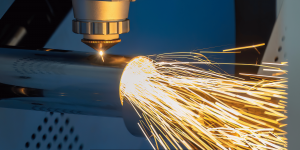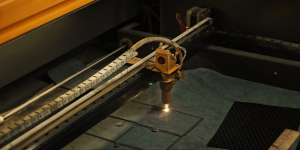Introduction to Laser Cutting
Laser cutting is a fabrication process that involves the utilization of a laser to cut materials. The laser beam melts, burns, or vaporizes the material, producing a clean, smooth, high-quality edge. Laser-cutting technology is applied in different industries to cut flat sheets, structural steel shapes, and piping materials.
How Laser Cutting Works
Laser-cutting machines can be described in terms of three primary components: the laser generator, the control system, and the assist gas system. The laser generator is also used to generate a narrow, straight laser beam to cut the material. The focused beam is directed towards the material through a nozzle. It is controlled by the machine’s optical system as well as CNC. What happens is that when the laser beam is directed to the material, it fuses, evaporates, or combusts the material. At the same time, the assist gas removes the debris and molten material. This makes it possible for the beam to cut through the material and create a clean edge free from marks or other imperfections.
About Laser Cutting and Its Many Applications
There are several different types of lasers used for cutting materials:
– CO2 lasers: The most common type used for cutting. The CO2 lasers use carbon dioxide, helium, and nitrogen gases to generate a beam with the appropriate wavelength for cutting, dull, or engraving.
– Fiber lasers: These utilize optical fibers with rare earth ions such as ytterbium and erbium to generate an intense laser light. Another advantage of fiber lasers is that they offer very high levels of accuracy in cutting.
– Solid-state lasers: These use a crystalline material such as ruby or sapphire together with light from a lamp to produce laser light. In contrast to gas lasers, solid-state lasers are less powerful but possess high accuracy.
– Diode lasers: Diode lasers employ diodes and are compact and efficient. However, it has lower power levels than CO2 and fiber lasers type laser machines.

Uses of Laser Cutting
There is a wide range of materials that can be cut by laser cutting machines in industries like manufacturing, automotive and aerospace:
Basic operations like Cutting Metal Sheets and Plates
– A laser can cut stainless steel, aluminum, copper, and galvanized steel sheets almost perfectly with sharp edges. Lasers offer high accuracy and flexibility in cutting complex outlines through holes and recesses.
Cut pipes and structural steel profiles.
– Laser cutting machines can make cuts of bevels, miters, holes and other profiles in steel pipes, square and rectangular tubes, I-beams and angle iron. The parameters of 3D cutting are flexible and allow for the omission of additional operations.
Cutting Fabric and Textiles
– Laser cutting can work on synthetic fabrics, such as polyester, nylon and acrylic, and natural fabrics like cotton and wool if secured to a surface with a clamp. Lasers offer the ability to cut out patterns, slits, and holes, as well as the embroidered pattern.
Cutting Plastics and Polymers
– Laser cutting can be effectively and efficiently applied on engineering plastics such as acrylic, PVC, polyethylene, ABS and chemically resistant plastics. It is quite a clean process and has minimum chances of the material getting damaged or warped.
Dissection of the Processes of Sawing Wood, Cutting Paper, and Leather
– Cutting of wood veneers, compressed wood, paper, and card stock through laser cutting offer a level of detail that blades or routers cannot offer. Leather for instance can also be laid on a laser cutting machine to achieve thin and intricate cuts and engravings.

Cutting Glass and Ceramics
– The slicing of glass sheets is done using laser, either straight or curved. Glass and ceramics of up to a certain thickness can be s awed without damaging the material.
Cutting Food Items
– Bread and pastry, watermelon, potatoes or any vegetables of your choice, all can be cut into attractive shapes and sizes through laser cutting. The cuts are very sharp and neat.
Conclusion
Cutting is a significant fabrication and manufacturing process that offers high accuracy and precision in slicing various materials. It is also possible to cut materials in more difficult 2D patterns or even 3d forms using multi axis laser cutting. The process is neat, efficient and reduces or even eliminates secondary finishing processes most of the time. It can be expected that as the laser cutting technology has the potential for automation as well as the mass production, it would see increasing application across the old and new industries.
